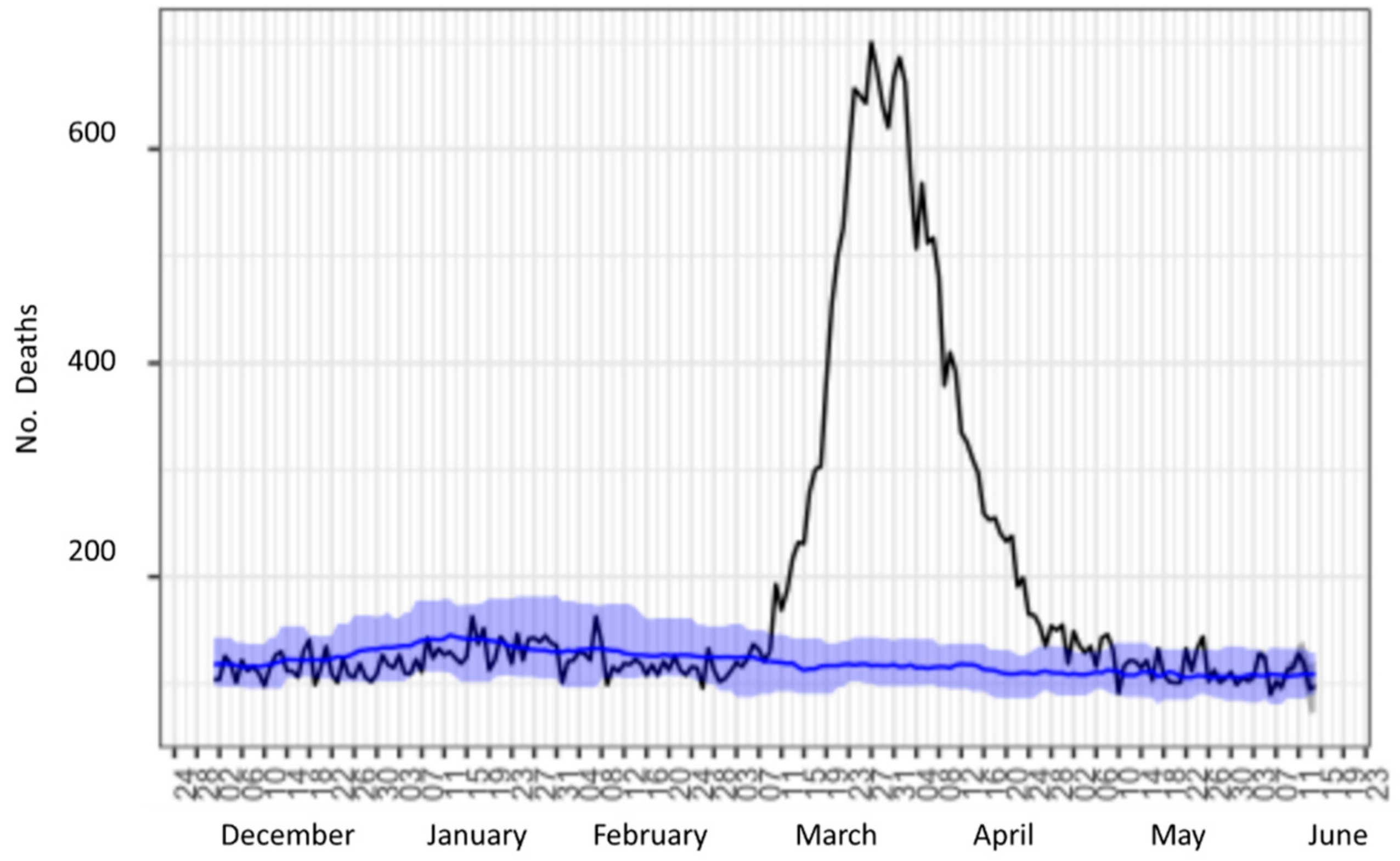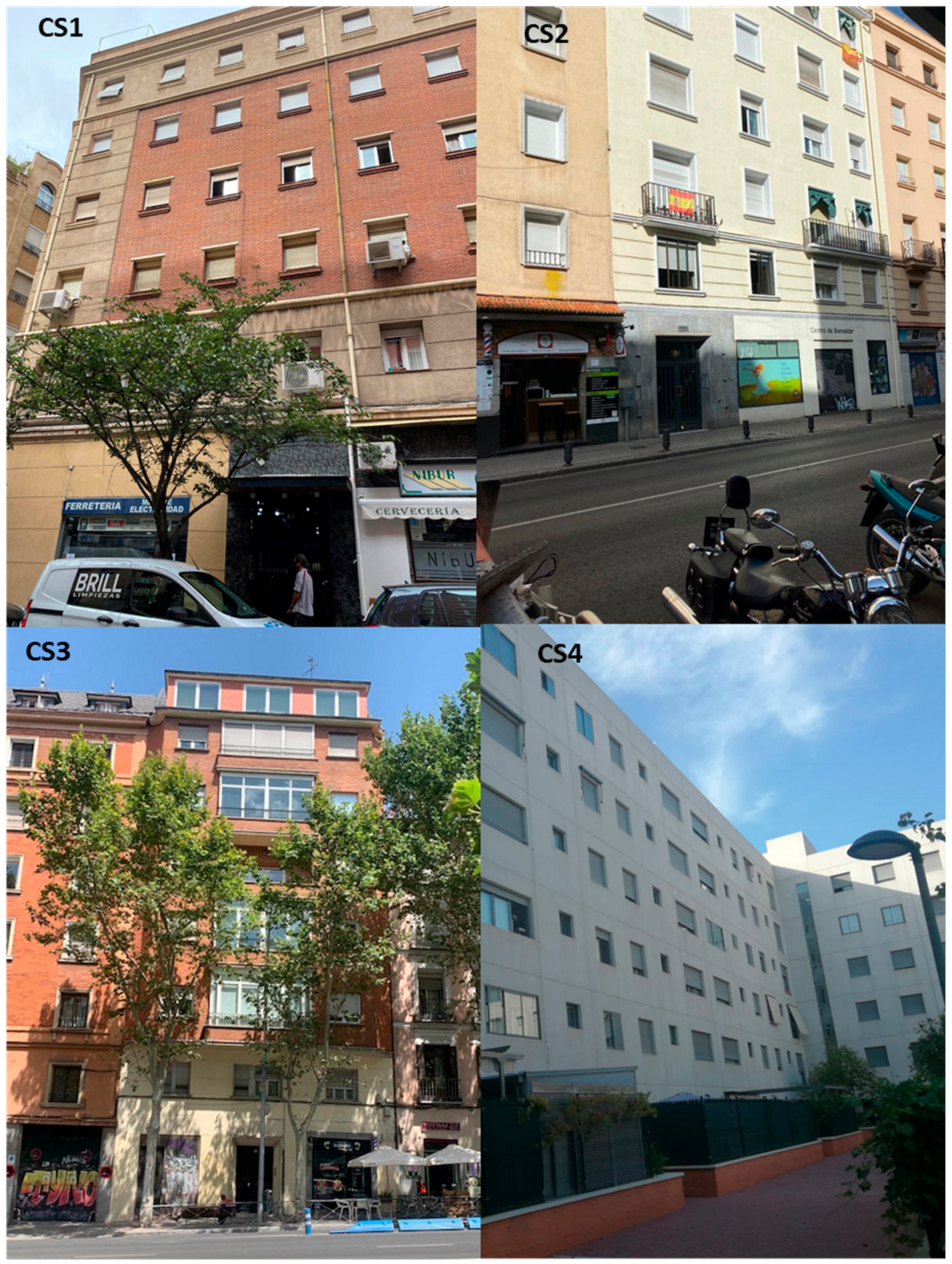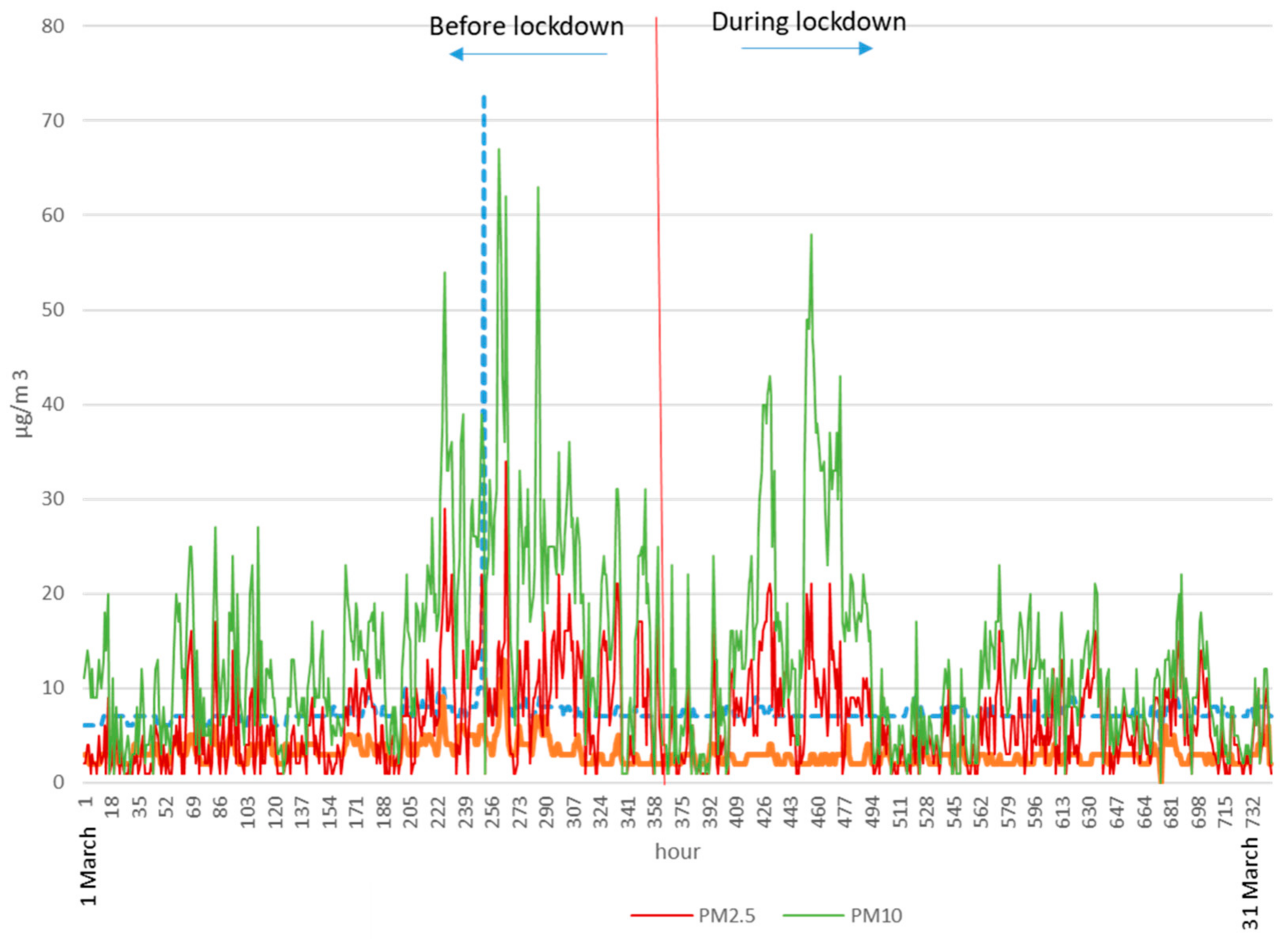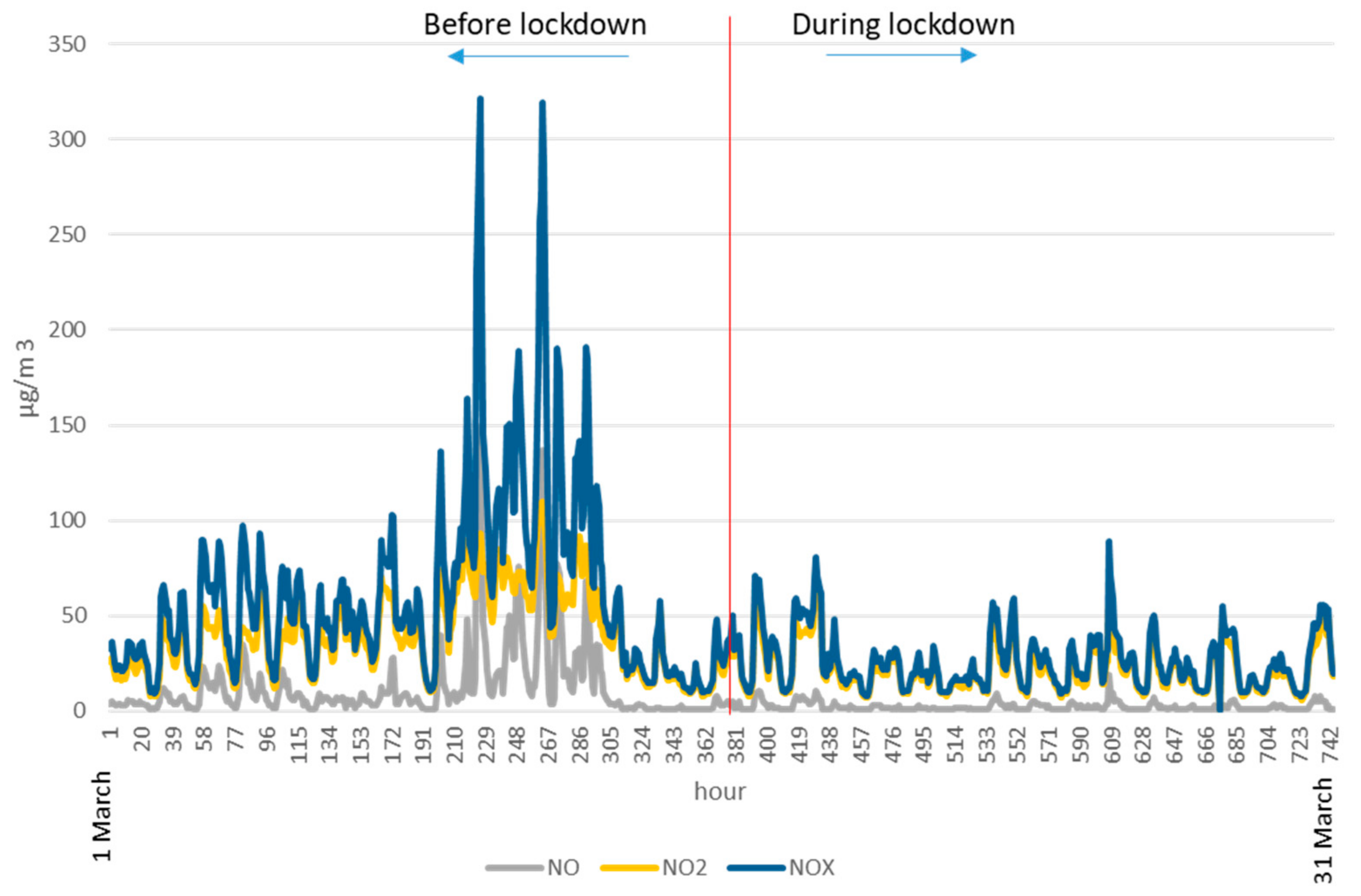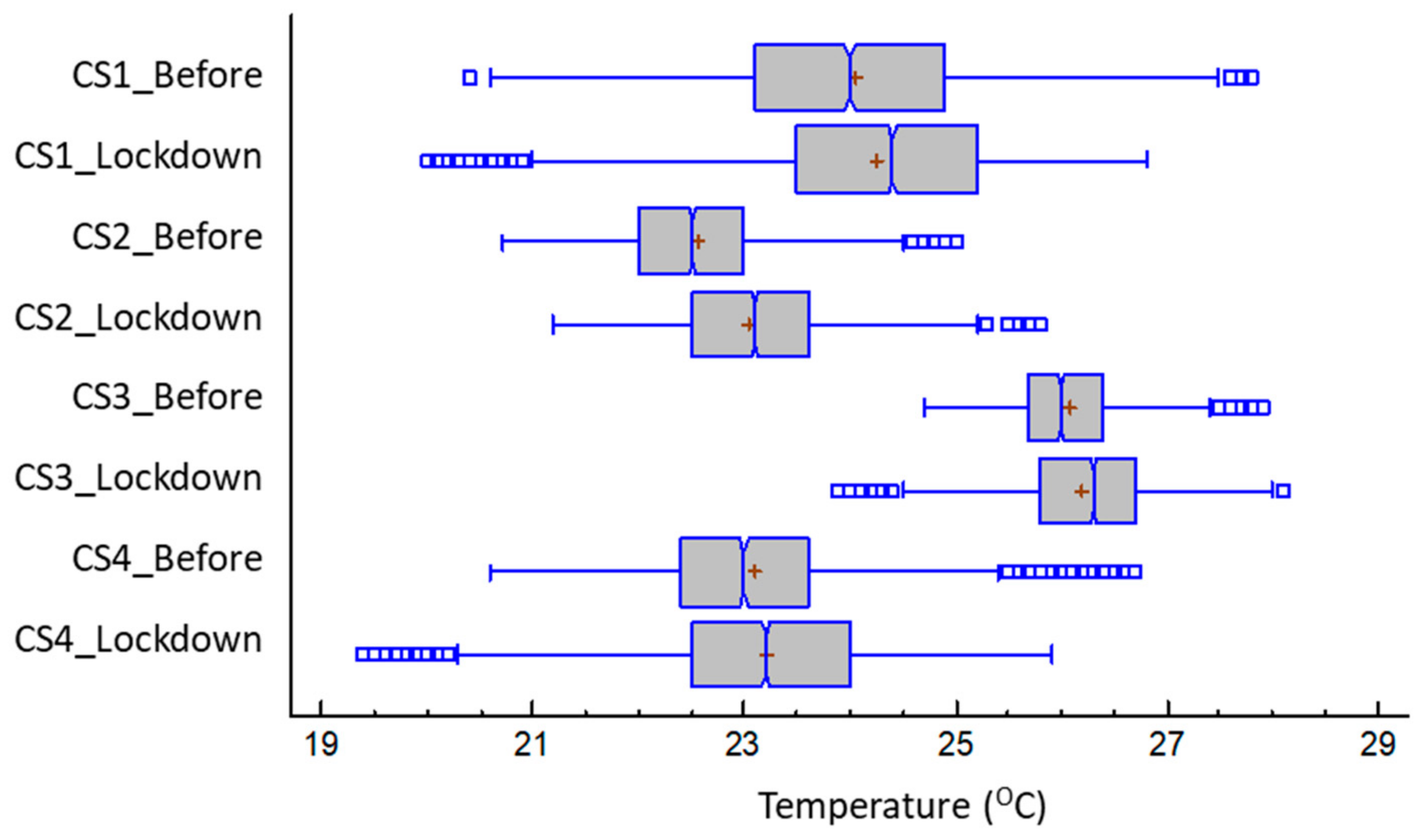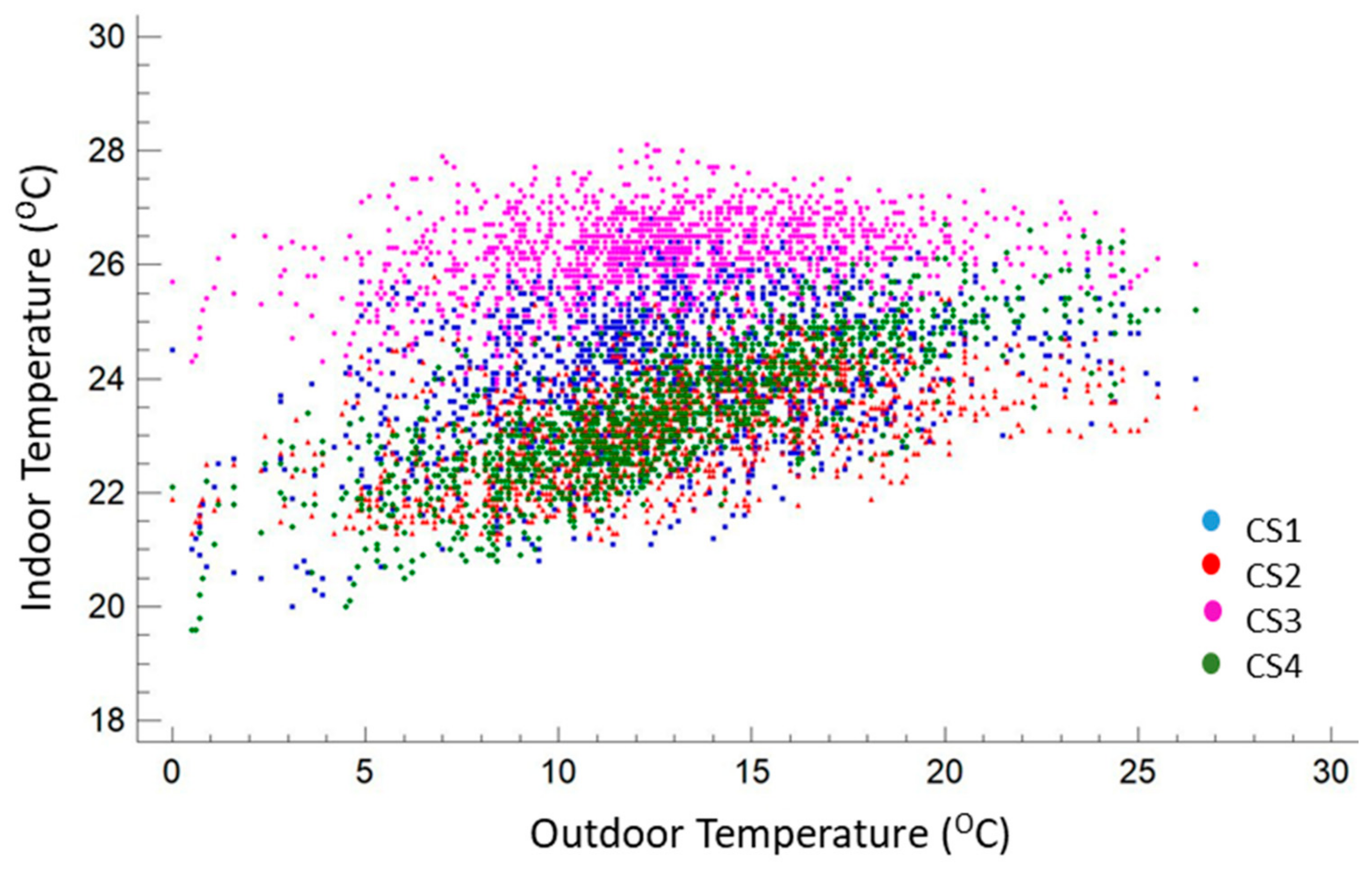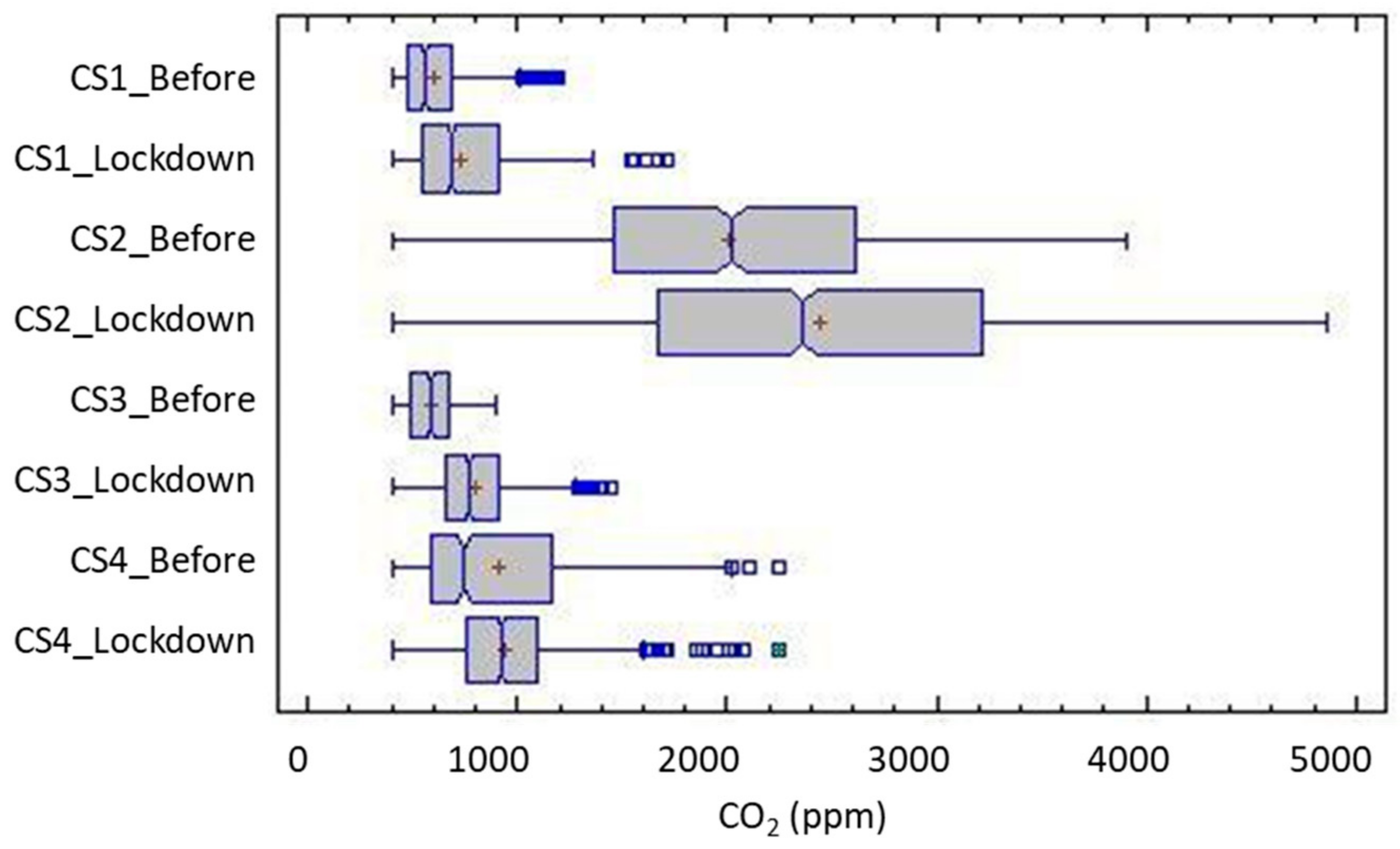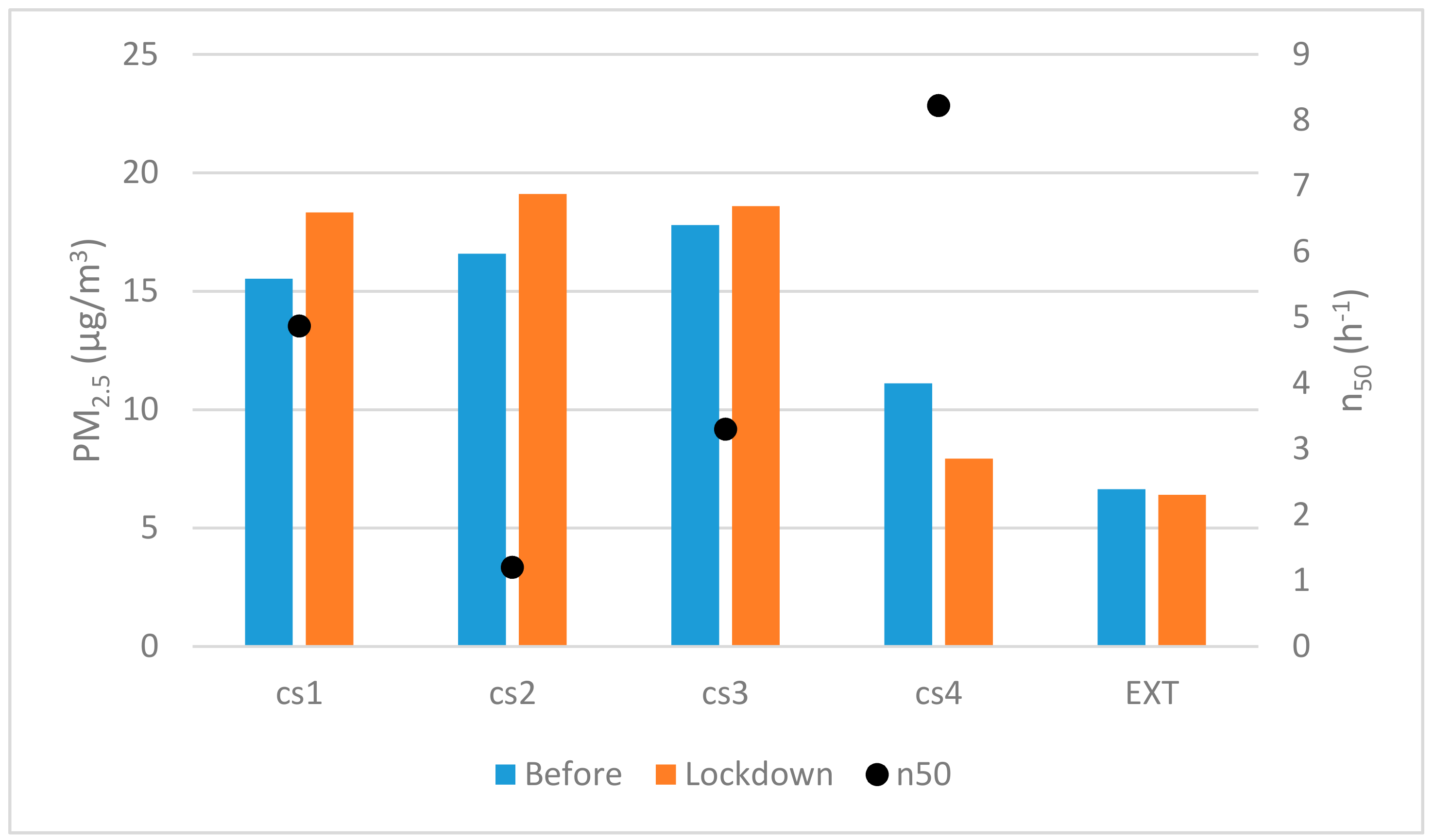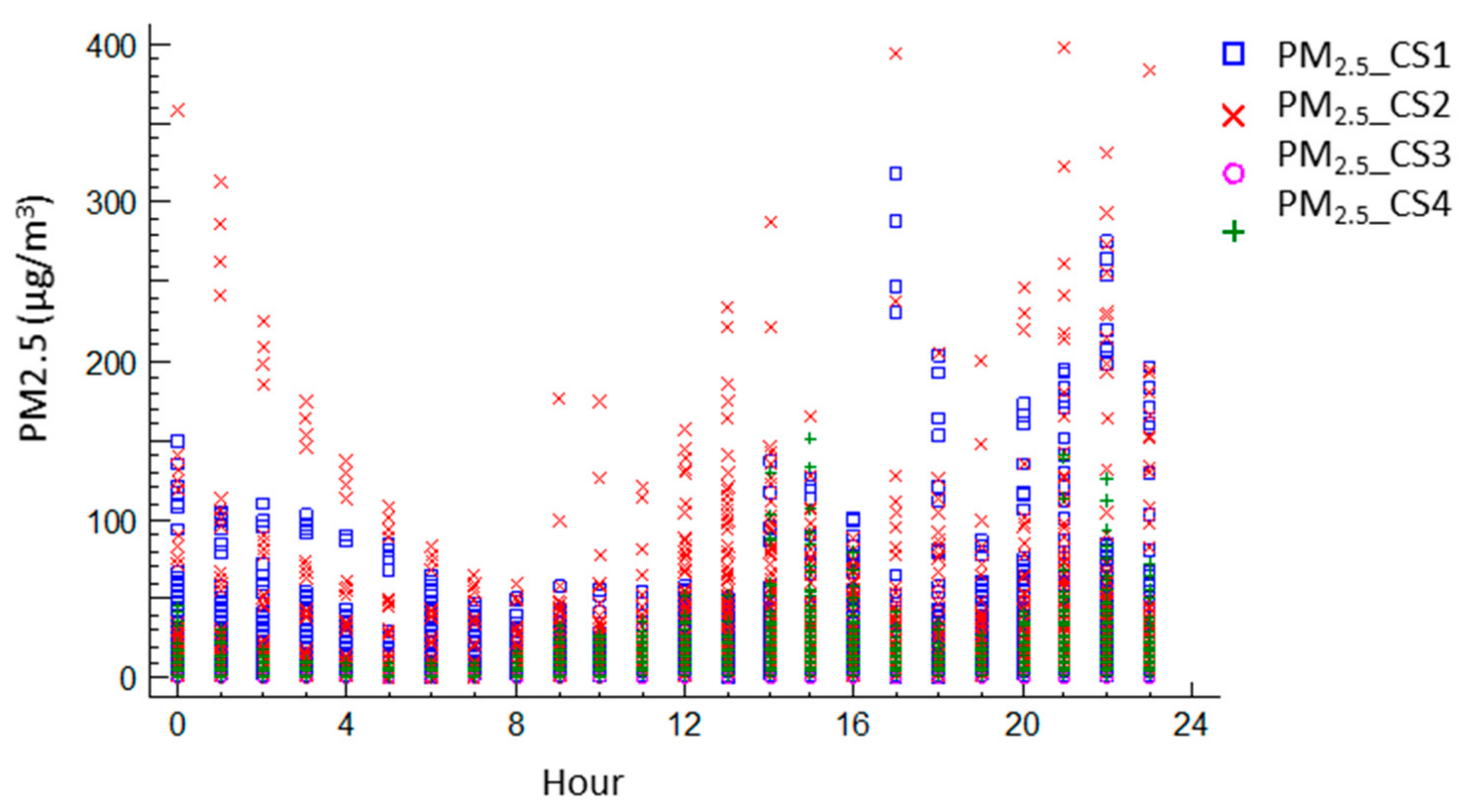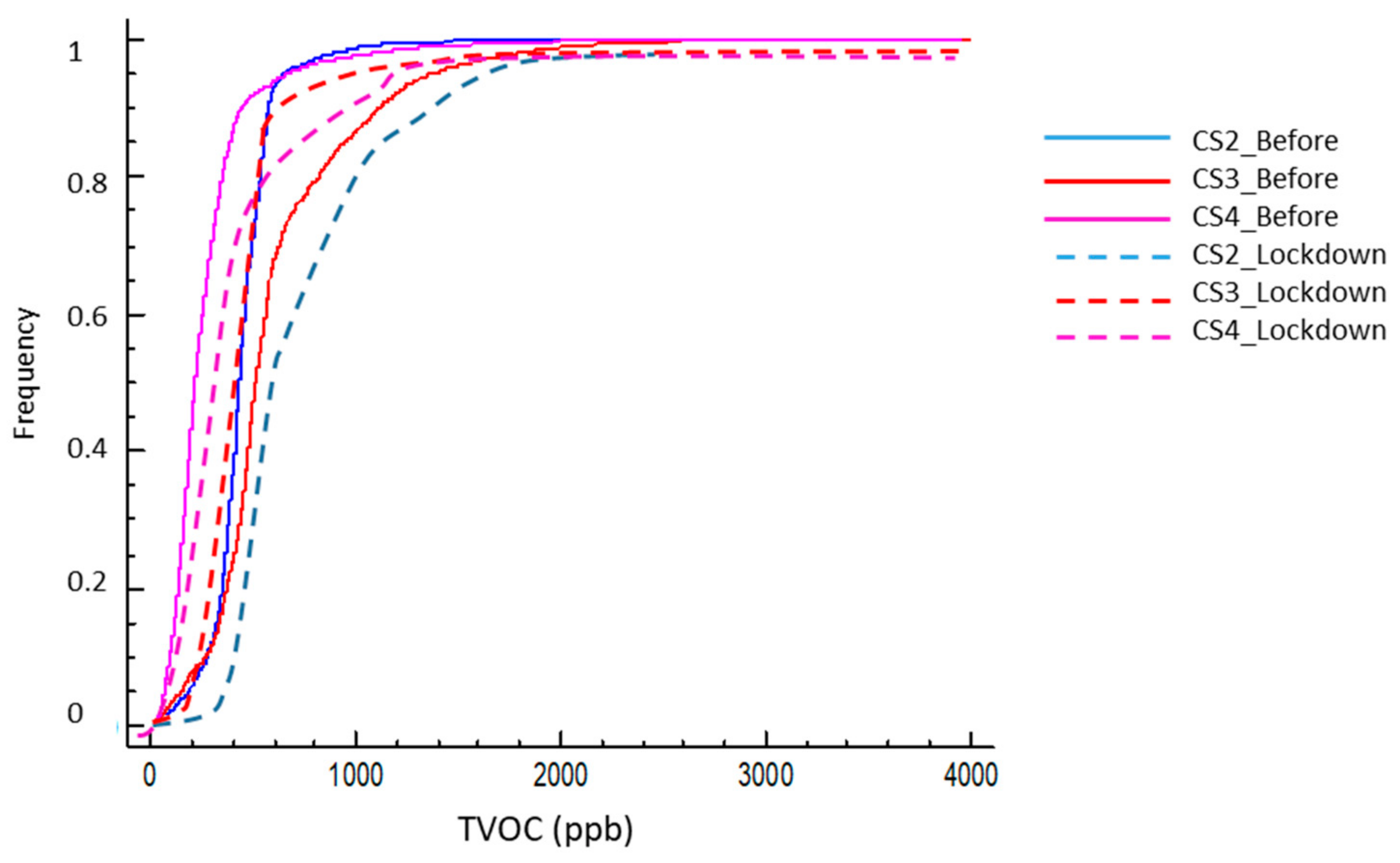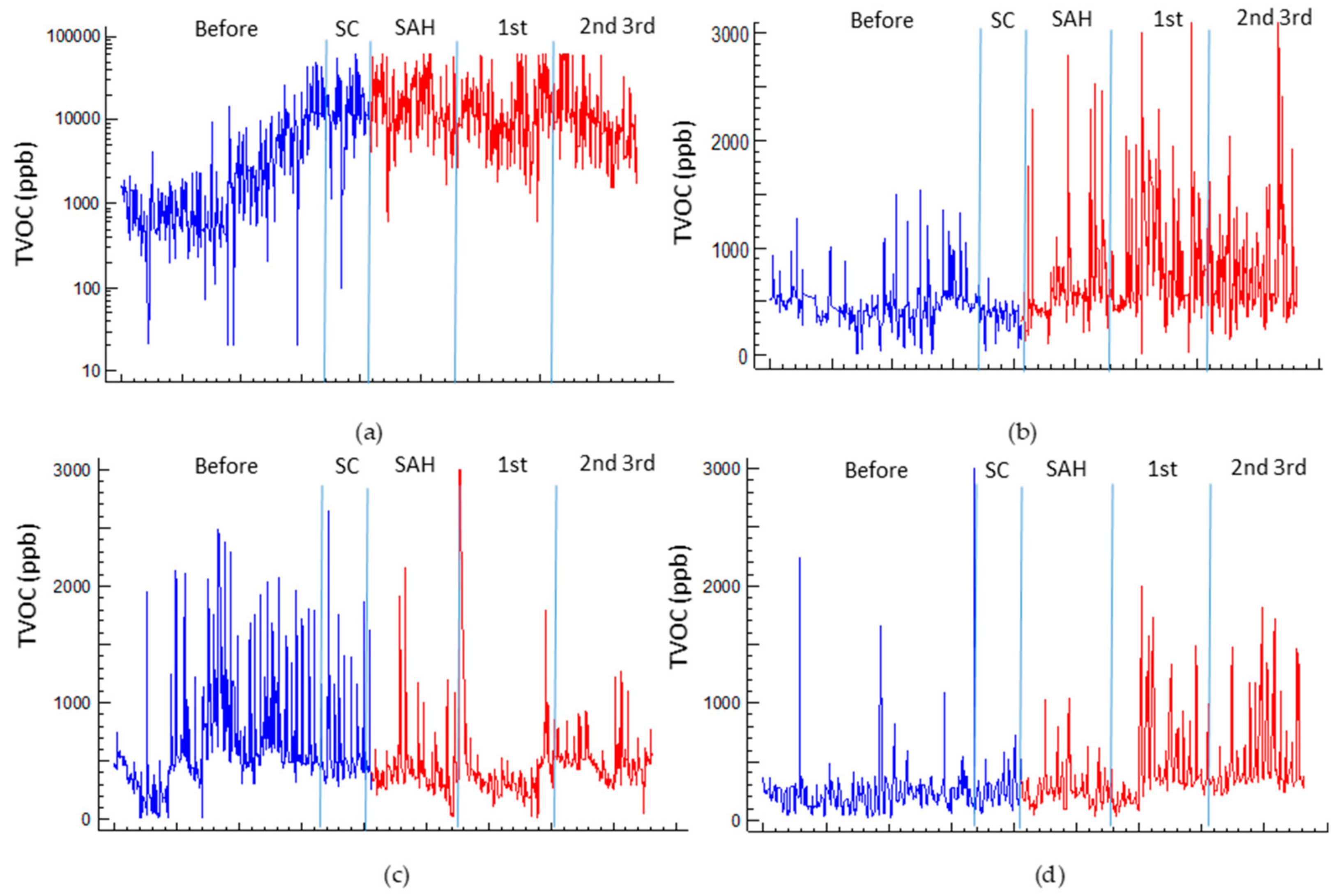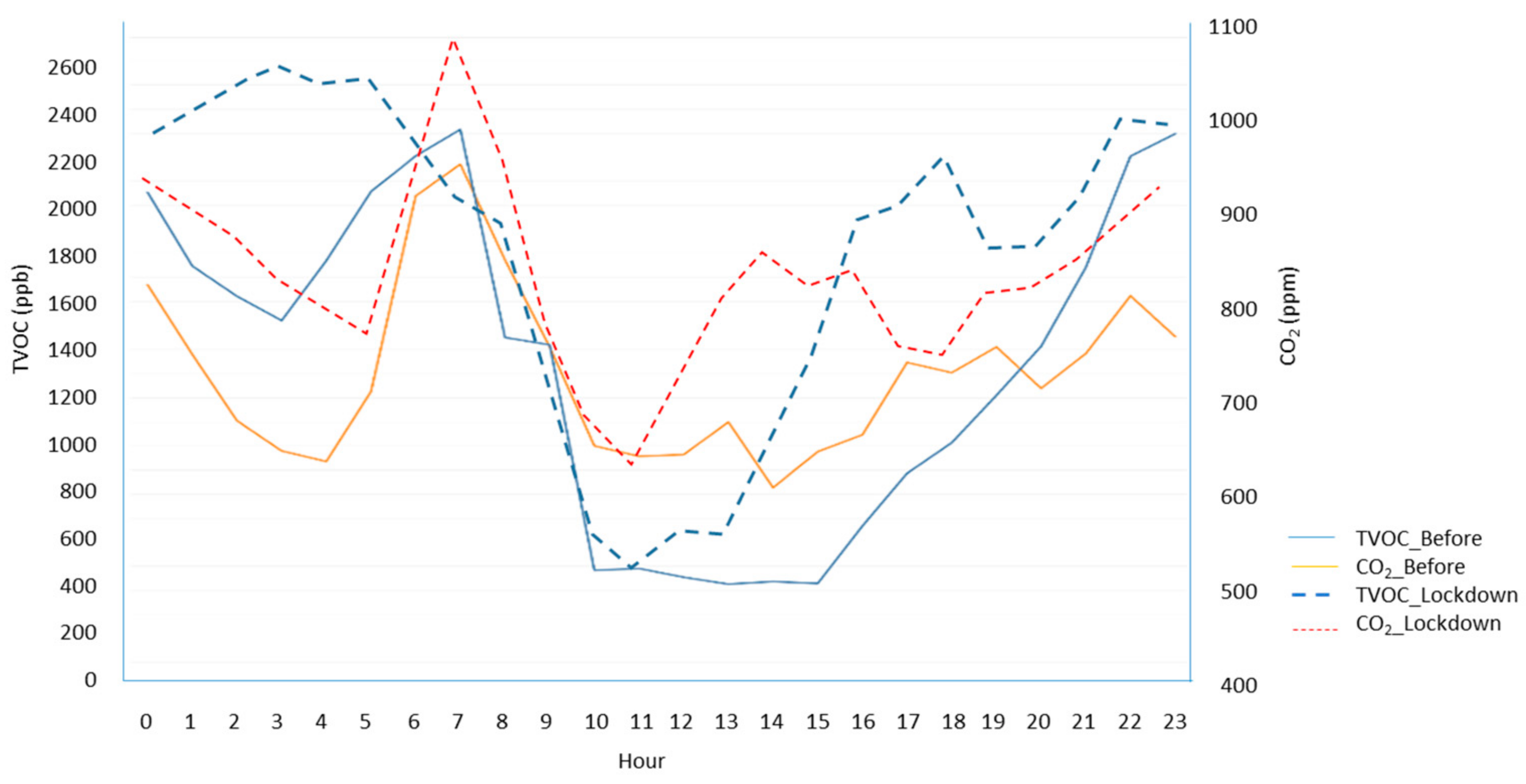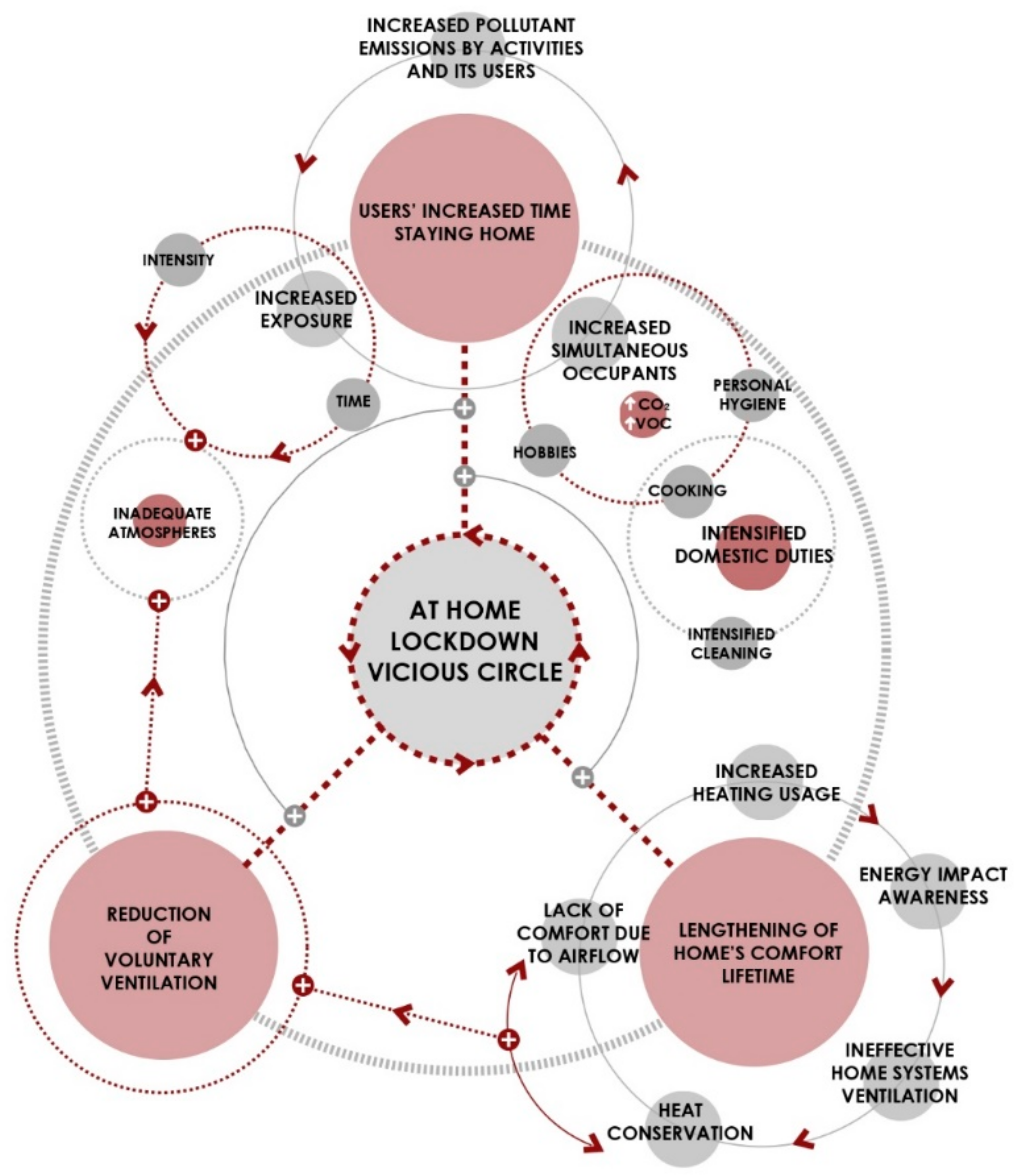3.3.1. Temperature and Relative Humidity
The month of March 2020 in Madrid was thermally usual, with average temperatures around the typical values (average temperature of 11.4 °C and an anomaly of +0.2 °C), although there were differences between the beginning of the month and the end: the highest temperatures occurred on 11 and 12 March (the days prior to the confinement), even exceeding 25.0 °C at some points, decreasing toward the end of the month. The minimum occurred on 31 March with a value of 0.1 °C, this also being the day of maximum rainfall. The month was, in general, very humid with rainfall above the typical values (57.3 L/m
2). The month of April, when most of the confinement was developed, and especially the severe restriction phase, began with low temperatures (minimum of 3.4 °C) reaching the highest maximum temperatures around 25 April at 23.5 °C. In general, the month was warm (average temperature of 13.8 °C and +0.9 °C of anomaly). Like the previous month, April was also very humid (the sixth rainiest month of April in the 21st century with 16 days of precipitation including storms) [
60]. The period prior to confinement had an average outside temperature difference of +2.5 °C with respect to this the confinement period.
The dwellings presented a certain heterogeneity in their air temperature values (
Table 4 and
Table 5), with the median temperature values in the period prior to the confinement being between 22.5 and 26 °C—these being more representative than the averages due to the presence of specific extreme values. During confinement, the dwellings become warmer in general, above all due to continuous human presence in the daytime hours, moving these central values to 23.1 to 26. °C, showing a range between +0.2 to +0.6 K.
ANOVA was performed with an F-ratio of 5675.66 (p-value < 0.05) to establish the statistically significant difference between the averages of the eight variables. Using the Fisher’s least significant difference (LSD) test, we established that the sample sets had significantly different means with a 5% confidence. Complementary tests were performed for the other statistics parameters and we established the difference for all cases (p < 0.05).
Typical temperature values were higher than recommended by the national standards (Energy performance of buildings directive EPBD national transposition call for a 17 to 20 °C profile for winter and Heating Ventilation Air Conditioning HVAC regulation for a set-point of 21–23 °C) with most averages being over this threshold for both periods (
Figure 6).
These relatively high values standards expected may be associated with the low capacity of the thermal envelope to moderate the thermal wave, since most of the samples were dwellings from the 1950s without thermal insulation and, therefore, have low radiant temperatures during the winter. Therefore, high air temperatures must be used to achieve comfortable conditions, which becomes more evident as the occupation of the dwellings increases. Lower temperatures were usually found in CS 4 despite the building having particularly sensitive inhabitants, such as children and an elderly person.
This contemporary dwelling was built under the requirements of the first transposition of the EPBD and so had a greater insulating capacity of its makeup; therefore, a higher indoor radiant temperature allowing a lower heating air-temperature was set to achieve comfort. The minimum values remained high, around 20 °C, except in CS 3, which was somewhat higher. Based on its quartile distribution (
Figure 6), the dwellings were rarely below 21 °C, indicating that heating was continuously used even during periods of ventilation and dwelling cleaning. This aspect, although indicative of a maintenance of comfort, should be considered in terms of energy impact, especially during confinement where the requirements increased.
All the houses kept the heating on in March, although with different patterns. CS1 is the dwelling that had the heating switched for the most hours per day, a total of 12 h. Dwelling CS3 also had the heating switched on continuously for nine hours, and both with fixed power regulation. In contrast, in the other cases, the boiler operates intermittently with schedules programmed in CS4 and CS2 governed by a thermostat (
Table 6).
Although the dwellings had a heating system with a continuous operation (from 24/24 to 9 h a day), their control—when provided (CS 2 and 3)—and/or power sizing did not seem to provide a moderately stable environment, introducing significant oscillations and a thermal evolution linked to the external conditions, as shown in
Figure 7. For verification, a correlation analysis was conducted by applying the Pearson product-moment (
Figure 8), in this case between the exterior and interior temperature to evaluate the strength of the linear relationship between the variables. The
p-value was used to verify the statistical significance of the estimated correlations (in this case, correlations significantly different from zero with a confidence level of 95.0% for all cases). CS3 had the weakest relationship, being closest to stable thermal control, with a value of the coefficient of 0.24. Conversely, dwelling CS4 was the most directly influenced by the evolution of the external temperature, with a value of the coefficient of 0.78 in the correlation. This behavior may have been associated with the highest permeability of the group (n
50:8.2) with a somewhat high value in relation to the typical values [
52] with a higher outdoor air infiltration rate.
Because the weather was generally wet during this period, outdoor relative humidity (RH) values were typically high, averaging between 58% and 67% before and during the confinement period, respectively. However, the influence on the interior atmosphere of the different cases was not significant, mainly due to the action of the heating systems. These keep indoor relative humidity in ranges typical for heated spaces, around 40% RH. The greater temporal extension of the presence of occupants did not seem to generate appreciable alterations. The pre- and during-confinement values only showed a slight increase, but without a clear statistical significance when comparing the distribution pairs (
p-value > 0.05), contrary to the temperatures. This weak effect was also related to the increase in indoor temperatures, which compensates, at least in part, for the foreseeable increase in vapor pressure due to the longer presence of occupants in the dwellings. Notably, the CS2 dwelling usually had high interior humidity (between 55% and 78%), although this situation occurred both before and during confinement, so the operation of the dwelling did not significantly change. This dwelling was the most airtight, with a very low figure for a dwelling of this period (n
50 1.2 r
−1) [
61]. In addition, it had one of the lowest available living volumes, around 50 m
3 per person. Both factors, together with reduced ventilation, fundamentally oriented toward energy conservation, seem to be responsible for these interior humidity values even with the operation of the heating. This aspect for CS2 was also present in the average indoor values of the pollutants, as noted in the following sections.
3.3.2. CO2 Concentration
Although CO
2 is typically considered the main indoor pollutant index, its main role when monitoring indoor environments is as an indicator of the effectiveness of ventilation and the renewal capacity of the indoor atmosphere. In general, work on IAQ adopts CO
2 concentration as an indicator of actual ventilation rates [
62,
63,
64,
65,
66] or as an index of indoor air quality [
65,
67]. Therefore, although it is not considered a major indoor air pollutant, high levels of CO
2, above 1000 ppm (corresponding to a ventilation rate of approximately 8 L/s per person [
68]), often indicate poor ventilation and the presence of other pollutants. Adverse health effects are also associated with levels above 5000 ppm due to oxygen displacement in the air [
69], a situation not commonly found in homes. The main emission agents are the occupants of the indoor environments, although the frequent use of open combustion equipment such as gas stoves, boilers, and Domestic Hot Water inside the home, especially in social housing, should be considered.
In general, the dwellings started with an acceptable air renewal situation as the CO
2 profiles indicate, except for CS2. Typical values are usually below the threshold of 1000 ppm for those found in dwellings of a similar type [
42]. Median values ranged from 696.1 (single-occupant) to 844.3 ppm (five-occupant). In dwelling 1, the presence of an usual smoker and pets resulted in an more conscious awareness of ventilation, and frequent window opening, although not necessarily adequate or effective, was reflected in the typical values: median of 783 ppm (σ: 225.95).
In dwelling 2, as identified in the analysis of relative humidity, the recorded values were much higher than in the rest of the sample, indicating a limited renewal of the interior atmosphere. Under normal operating conditions (outside of confinement), the dwelling had values well above the threshold recommended by the World Health Organization (WHO) (
Table 7), which were different from the rest of the dwellings in the sample indicating poor ventilation routines, as was noticed in the previous section.
The imposition of the stay-at-home order produced a significant modification of the indoor quality of the dwellings, with a general rise of the indoor CO
2 values in all cases (
Figure 9 and
Table 8). This alteration affected both the central values, with an increase in the median concentration around 7% to 12%, altering the shape and position of the distribution. Although this increase was foreseeable, given the increase in the time of occupation and permanence in the dwellings, it is especially indicative of a worsening of the indoor air quality under these conditions. Voluntary ventilation appears not to have adapted to these circumstances, either due to specific self-limitations or the absence of awareness and behavioral changes by users.
Figure 10 shows the quantile graph for indoor CO
2 concentration. The reduction in density occurred with an adequately ventilated atmosphere in the time analyzed, adopting the threshold of 1000 ppm CO
2 as an indicator. In general, this alteration was around 10% in three cases, with a smaller increase for CS2, although its values were initially very low, going from a proportion of 0.12 to 0.08 for the threshold of 1000 ppm. This means that during confinement, ventilation in case 2 was only adequate less than 10% of the time. In the rest of the cases, although the values were usually better, the confinement situation worsened the ventilation, with the time of exposure increasing to potentially inadequate atmospheres. Unlike the situation prior to lockdown, during confinement, it can be assumed that the occupation of the dwelling was constant for the whole period, as opposed to cycles of occupation/inoccupation typical of prior to lockdown.
The temporal exposure is relevant, which can be represented by its cumulative distribution (
Figure 10). This shows the density of the frequency in which the interior atmosphere could be considered adequately ventilated for each period—assuming 1000 ppm of CO
2 as the threshold. Confinement decreased the frequency in which the environments were below the threshold in all cases. In general, this alteration was around 10 percentile points in the three cases, with a smaller jump in the CS 2 case, although its frequency values were already initially low (decrease from a proportion of 0.12 to 0.08 for the 1000 ppm threshold). This can be interpreted as that, during confinement, the ventilation in Case 2 was only adequate less than 8% of the hours.
In the rest of the cases, although the values were typically better, the confinement situation worsened the ventilation, with an increase in the time of exposure to poorly suited atmospheres. Unlike the previous situation, during the confinement, we assumed a constant home occupancy, compared to the cycles of occupation/empty-house that are typical of the usual routine.
3.3.3. PM2.5
Airborne particles are solid or liquid substances suspended in the air stream, and can include dust, fumes, smoke, microorganisms, mists, and fogs [
70]. These particles can vary widely in diameter, with the most harmful in the domestic environment being respirable suspended particles (RSPs), especially the fine inhalable particle fraction sized 2.5 μm or less (PM
2.5) [
71,
72,
73,
74].
The World Health Organization (WHO) has established reference target values both for long-term exposure concentration with annual means under 10 µg/m
3 and short-term guidance for the 24 h means recommended to be under 25 µg/m
3 at the 99th percentile (3 days/year) [
75]. The European limit value for the annual average is higher at a 25 µg/m
3 limit. The outdoor concentration of PM
2.5 for Madrid did not present significant variations between the initial period and the lockdown except for specific peaks, with a daily average around 6 μg/m
3, although some decrease was observed during the reinforced lockdown (1st extension period).
Therefore, the external situation can be understood as relatively steady. These figures are also typical for the city as it is one of the few European cities that consistently stays below the EU and WHO recommendations [
76]. However, there is a general consensus on the need to keep the levels of exposure to PM
2.5 as low as possible, as it has not been possible to establish a minimum safety threshold without health effects, especially inside buildings [
77,
78,
79]. The reduction of exposure has especially positive effects on sensitive inhabitants, such as individuals with respiratory conditions, the elderly or children [
80,
81]. Likewise, there appears to be evidence that exposure to PM of internal origin is more aggressive in the respiratory effects than of external origin, with a greater capacity for lung response [
82,
83]. As a reference, the typical mean residential indoor concentrations in Europe range from 7 (Helsinki) to 21 μg/m
3 (Athens) [
84] and up to as high as those in Italy with 50 μg/m
3 by Gotschi et al. [
85].
Although there are innumerable outdoor sources, there are also internal sources responsible for the emission of particles, which can assume a special role in situations of high intensity use of indoor spaces, such as during a confinement situation. One of the main sources of particles inside residential buildings is cooking, as food preparation causes the emission of vapor, smokes, and aerosols [
86,
87] and smoke and effluents can be released indoor if there is a lack of a suitable extraction system and by indirect paths due to the possibility of gas-reentry through the infiltration airflow [
88,
89]. While not as common in residential buildings as they are in offices and public buildings, the presence of printers may also contribute to particle emissions—they are a significant VOC source [
90]; however, due to the wide spread of teleworking and tele-teaching during confinement, their presence increased significantly in homes, as well as their use, so they must be taken into account in the analyses.
Another large contributor, which is increasing in homes today, is the use of cleaning agents [
91,
92], as well as cosmetic and personal hygiene items (deodorants, hair sprays, etc.) [
93]. Although these are not typically taken into account, the use of electric air fresheners also has a high capacity for emitting particles [
94,
95,
96]. Since airborne particles are deposited on adjacent surfaces, one of the aspects with the greatest influence on the increase in indoor particle concentrations is the re-suspension due to the movement of the occupants. [
88]. This happens very frequent and intensely in indoor environments with regular movement and a low ratio between volume and inhabitants, such as is the case in homes [
97,
98]. In addition to the emissions caused by the cleaning products, the cleaning process itself, with surface cleaning, sweeping, and other motions, has been identified as an activity responsible for the resuspension of the particles and, therefore, of increased concentrations in the air [
99].
In general, the indoor averages of both periods were higher than the city reference outdoor values, as shown in (
Figure 11). In the period prior to confinement, the dwellings showed an average between the double (CS4) and triple (CS3) of those found outdoors. During confinement, the averages increased, except in CS4, with central values more than three times the external ones. This issue highlights the significant contribution of indoor sources of emissions, a situation that intensified during confinement.
The higher or lower air-permeability of the envelope did not appear to play a significant role in the indoor PM
2.5 concentrations through the fabric particle penetration process, as there were high levels of concentration both in airtight homes (CS2) as in average permeability homes (CS 1). Nevertheless, the less airtight dwelling (CS4)—beyond the stock average value [
61]—was the one that typically had the lowest PM
2.5 concentrations. In this case, the airtight homes could benefit from greater air-dilution through the base infiltration, which would contribute to maintaining greater control over the indoor concentration when there are scenarios of limited indoor emissions unlike in CS1. These questions, although require a more comprehensive and in-depth study, which shows a line of interest for future work, and does seem to indicate the prevalence of internal source dynamics over external source dynamics in this situation.
Adequate information on the evolution of particulate matter can be obtained through daily averages, representative of short-term exposure. The representative values before and during confinement are shown in
Table 9 and
Table 10, represented by the medians and their associated statistics. The typical 24-h average values were initially above 10, although some days had values rise to 57.72 µg/m
3. In general, as was more evident in cases 1 and 2, the inter-days variation was high, alternating days of low emissions with higher ones, a situation linked to the routines of these households—regular and irregular cycles.
During lockdown, the previously identified values rise was identified in detail as a general increase in the daily average values except for CS 4, with an increase of 12% to 20% in the daily intensity. Likewise, the intra-day variability increased, with low and high emission cycles, reaching mean values of 24 h as high as 90.43 for CS 2. This increase can be associated with two basic aspects: the increase in cooking with regard to the previous conventional routine, which set the base values as is repeated in 24-h cycles, as well as by the intensification of domestic cleaning and housekeeping tasks with respect to the normal situation, which was not developed daily but on separate days. Specific short-time high-peak emissions events were identified in all the homes, although they were not representative (values went up to 1000 µg/m3 in certain cases).
Although the period-means (prior/lockdown time) are referred to as a median-term exposure (around 45 days for each set of measures) those figures are above the annual recommended target for WHO. While a direct comparison is not possible, this may indicate a potential risk of exposure if forecasted over time. Of greater interest is the comparison of the WHO limits for the 24-h averages (25 µg/m3), which were exceeded for a significant number of days in each period.
In the normal situation, the percentage of days when this threshold was surpassed were: 4.65%, 16.6%, 53.3%, and 2.32% (for cases 1 to 4) and during the confinement these figures increased to 16.6%; 22.9%, and 5% for cases 1 to 3, and CS 4 did not exceed the values on any day in the period. As the epidemiological evidence shows the adverse effects of PM are linked to both short-term and long-term exposures [
100]. In this case, the apartments started from an initial profile that was not good—in this period, the actual exposure was lower as the occupation time was also shorter—that worsened during confinement, increasing the risk for the occupants of the dwellings, against the short-term exposure levels and related to the inhabitants—for instance, CS1 and CS2.
As indicated above, in the analysis of the temporal 24-h profile of particles emissions (PM
2.5) inside the homes, the peaks were associated with the periods of food preparation and daily cleaning, and, as shown in
Figure 12, the measures are represented in relation to their temporary presence during the confinement period. Notably, in Southern Europe, the time for dinner is later than in Central Europe, an aspect that seems to have intensified during the confinement period.
3.3.4. TVOC
Along with particles, the most common species in the home environment are volatile carbon compounds (VOCs), represented in this case by TVOCs. Nearly 900 VOCs have been identified in the indoor environment [
101], mainly related to interior furniture, finishes, and other construction elements, such as paints, solvents, adhesives, carpets, fabrics, and textiles, but above all to the presence of occupants in the dwelling and their activities, as well as the effect of increased turbulence in the indoor atmosphere caused by movement within the different enclosures (increasing the effect of mixing the pollutants). In urban areas, there are also external sources of VOCs, particularly those related to traffic as well as other combustion equipment. There is evidence that, in European residential and service buildings, the VOC levels are typically higher indoors rather than outdoors—often several times higher [
102,
103,
104]. Likewise, the action of the outside environment, either through ventilation or air permeability, will manifest in a greater or lesser dilution of this component indoors [
105].
Exposure to high concentrations of VOCs in air can result in a variety of toxicological effects, including fatigue, headaches, drowsiness, eye irritation, and many others [
106,
107]. However, the wide variety of potential sources and compositions makes it impractical to measure concentrations of each chemical individually. As such, the concept of total volatile organic compound (TVOC) attempts to address this practical limitation by providing a simple measure of the aggregation of all VOCs without distinguishing between individual chemicals. Although no unified regulation exists for exposure to total VOCs within the home, some general thresholds can be assumed as a result of physiological responses of and disturbances to the occupants. In the range of 120 to 1200 ppb, symptoms of irritation and discomfort may begin to appear in some occupants. Above 12,000 ppb, this discomfort is generalized, with different manifestations depending on the degree of sensitivity of the inhabitants and the species present, with toxicity developing from 10,000 ppb [
108]. As reference levels, <120 ppb is considered a healthy environment or VOC-free and >1200 ppb is considered a risk environment with intermediate figures assumed as acceptable but not a risk-free situation. These considerations are general in nature and are highly variable depending on the type of VOC present in the atmosphere [
109].
The typical average outdoor levels of TVOC for Madrid (urban center) fluctuated around 14 to 2.85 ppb, although there was a large time variability and weather condition dependency [
56]. The most representative species in the city atmosphere were toluene and benzene [
14]. During the period prior to confinement, the average daily concentration was Tol: 0.86 and Ben: 0.343 ppb (max. extreme day of 1.75/0.50 ppb). These concentrations shifted to a significant reduction during the period of confinement, going down to a daily average of Tol: 0.146 and Ben: 0.085 ppb (extreme day of 0.39/0.188 ppb) for the last 15 days from March to the end of April. Therefore, there was a significant drop in the VOC outdoor air presence, both on average and extreme days, which may be associated mainly with the drastic reduction of city traffic. This highlights that, during the confinement period, the influence of the outer species, although present in the interior, were not the main drivers of the high interior levels and the evolution observed between periods.
In the case of TVOCs, dwelling 1 was different from the rest as it had one smoker and, even if smoking was not conducted directly in the home, this did present indirect effects that affected the interior quality: the smoke residues on clothing, odors, etc. The high values usually found in this dwelling necessitated conducting the study independently from the rest of the sample. Since relatively high extreme values were found in all dwellings, although only occasionally, the value of the median was more appropriate than the average for representing the behavior of the indoor environment, as the latter is more affected by the presence of extreme values. Excluding CS 1, the medians, both prior to and during confinement, were within the typical findings of similar contemporary dwellings [
42], although these were higher than desirable and far from healthy environments. The representative values were within the acceptable label atmospheres, but their high variability, with a variation coefficient of 38.5% to 93.89% for the pre-COVID period and 58.95% to 109.88% for the confinement, indicates periods with high or very high levels of contaminant concentration that became more frequent during confinement.
Table 11 and
Table 12 show, respectively, the statistical data on the concentration of TVOCs (ppb) before and during lockdown.
The frequency over time of the different concentration levels for each time period offers an insight to the kind of exposure that each housing is presenting, which can be expressed through the concentration level temporal percentile. In the normal use of homes (prior to confinement) the exposure of users to high concentrations of VOCs was not very significant—except for case 1—and indoor environments usually maintained an acceptable quality threshold of 1200 ppb (92.5 to 99.5 percentile) (
Figure 13), with dwelling 3 being somewhat more exposed. This home was also the one with the highest peak values and width of the distribution—as well as the highest STD value (σ3: 397 ppb).
This can be associated to the profile with a single-inhabitant home and, therefore, the periods of activity/non-activity showed more drastic differences and had a less smoothed profile than others. However, only Case 4 presented significant good quality periods—considered VOC-free when under 120 ppb, with a percentile of 18% for this threshold. In the other situations (1 to 3), periods of low concentration were unusual—with percentile values between 3.0 and 4.3. The periods of occupation were not continuous, and the dwelling had several unoccupied hours.
However, during confinement, the usual concentration increased for dwellings 1, 2, and 4 (increases in the median from 37% to 559%). Excepting Case 1, cases 2 and 4 maintained their central distribution within the acceptable category despite the widening of their standard deviation (σ2: 441 and σ4: 347), although this threshold did not assure risk-free and the exposure increased as the time spent at home did. The time out of the over 1200 ppb threshold reduced in cases 2 and 4 (88% and 95%, respectively).
In Case 3, the opposite situation occurred, with a reduction in both the mean and the median (–22%), although with a widening of the standard deviation and a particularly high extreme value peak event. This highlights a changes in the indoor routines—less laundry, less use of cosmetic agents, and similar conditions, as described above—and the time below this threshold increased to 97% of the time; therefore, extreme values occurred at very specific moments and for short periods primarily linked to cleaning actions with higher values than before due to more intense actions but with less frequency.
Conversely, in all cases, the almost constant occupation of the dwelling caused the practical non-existence of low periods of VOCs (TVOC < 120 ppb), a situation that can be observed in its probability curves (
Figure 14) and the general increase in the values for the 5% percentile.
Dwelling 1, with smoking occupants, presented a unique case. VOC levels were usually high, both prior to and during confinement. Its initial median concentration was 1983 ppb with an average of 5500 ppb due to the presence of extreme values, and with a standard deviation much higher than that found in other dwellings (σ1: 7982). This indicated both a large width of the central part of the distribution as well as the presence of occasional situations of extraordinarily high values. This dwelling, under a normal situation, usually had an atmosphere with a high presence of VOC’s, being located most of the time within 354 to 21,696 ppb (5% and 95% percentiles), with very limited periods of good quality atmospheres (<120 ppb, 1.7%; <1200 ppb, 39%). However, the temporary presence of the occupants, with daily work cycles, to some extent reduced the exposure to these species.
During confinement, the concentration of TVOCs in CS1 increased in the medians, extreme values (maximums), and 95% concentrations. The median increased by an order of magnitude of more than five, raising the average above 15,000 ppb. The peak levels surpassed 60,000 ppb. This indicated a very continuous presence of substances at dangerous levels for both short- and long-term exposures. The imposition of confinement worsened the situation, as the hours indoors increased significantly, with the occupants being at risk of almost continuous exposure. In contrast to the previous situation, hours below 120 ppb were negligible (0.025%) and only 0.45% of the period was expected to have TVOC levels below 1200 ppb.
Although smoking related effects were are usually the main factor responsible for indoor peak emissions [
110,
111] concerning body and clothes residues, as reflected by the periods of activity in the dwelling and the time profile, this caused secondary emissions. To neutralize tobacco odors, in combination with the presence of domestic pets, electric air fresheners were used continuously, generating a continuous emission of VOCs, responsible for the identified high background level as informed by the inhabitants. This situation is compatible with the findings in [
21,
29,
112,
113], where the daily clothes laundry of the worker also contributed to the emissions.
The analysis showed a statistically significant difference in the sample distributions between the prior and lockdown situations (at a 95% confidence level) for the contrast tests (T, Mood, and Kolmogórov–Smirnov test K-S test) for each case (p > 0.05 in all cases). The data distribution of each case period, especially those for the confined state, better fit the log-log-type distributions compared with the normal.

